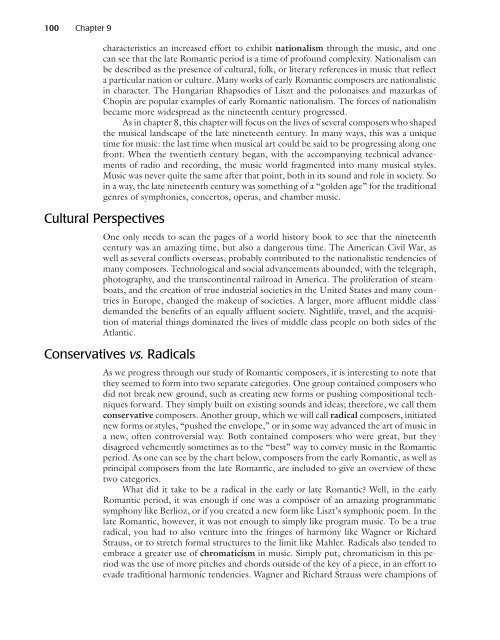Composer Profile - Activefolio
Composer Profile - Activefolio
Composer Profile - Activefolio
Create successful ePaper yourself
Turn your PDF publications into a flip-book with our unique Google optimized e-Paper software.
100 Chapter 9<br />
characteristics an increased effort to exhibit nationalism through the music, and one<br />
can see that the late Romantic period is a time of profound complexity. Nationalism can<br />
be described as the presence of cultural, folk, or literary references in music that reflect<br />
a particular nation or culture. Many works of early Romantic composers are nationalistic<br />
in character. The Hungarian Rhapsodies of Liszt and the polonaises and mazurkas of<br />
Chopin are popular examples of early Romantic nationalism. The forces of nationalism<br />
became more widespread as the nineteenth century progressed.<br />
As in chapter 8, this chapter will focus on the lives of several composers who shaped<br />
the musical landscape of the late nineteenth century. In many ways, this was a unique<br />
time for music: the last time when musical art could be said to be progressing along one<br />
front. When the twentieth century began, with the accompanying technical advancements<br />
of radio and recording, the music world fragmented into many musical styles.<br />
Music was never quite the same after that point, both in its sound and role in society. So<br />
in a way, the late nineteenth century was something of a “golden age” for the traditional<br />
genres of symphonies, concertos, operas, and chamber music.<br />
Cultural Perspectives<br />
One only needs to scan the pages of a world history book to see that the nineteenth<br />
century was an amazing time, but also a dangerous time. The American Civil War, as<br />
well as several conflicts overseas, probably contributed to the nationalistic tendencies of<br />
many composers. Technological and social advancements abounded, with the telegraph,<br />
photography, and the transcontinental railroad in America. The proliferation of steamboats,<br />
and the creation of true industrial societies in the United States and many countries<br />
in Europe, changed the makeup of societies. A larger, more affluent middle class<br />
demanded the benefits of an equally affluent society. Nightlife, travel, and the acquisition<br />
of material things dominated the lives of middle class people on both sides of the<br />
Atlantic.<br />
Conservatives vs. Radicals<br />
As we progress through our study of Romantic composers, it is interesting to note that<br />
they seemed to form into two separate categories. One group contained composers who<br />
did not break new ground, such as creating new forms or pushing compositional techniques<br />
forward. They simply built on existing sounds and ideas; therefore, we call them<br />
conservative composers. Another group, which we will call radical composers, initiated<br />
new forms or styles, “pushed the envelope,” or in some way advanced the art of music in<br />
a new, often controversial way. Both contained composers who were great, but they<br />
disagreed vehemently sometimes as to the “best” way to convey music in the Romantic<br />
period. As one can see by the chart below, composers from the early Romantic, as well as<br />
principal composers from the late Romantic, are included to give an overview of these<br />
two categories.<br />
What did it take to be a radical in the early or late Romantic? Well, in the early<br />
Romantic period, it was enough if one was a composer of an amazing programmatic<br />
symphony like Berlioz, or if you created a new form like Liszt’s symphonic poem. In the<br />
late Romantic, however, it was not enough to simply like program music. To be a true<br />
radical, you had to also venture into the fringes of harmony like Wagner or Richard<br />
Strauss, or to stretch formal structures to the limit like Mahler. Radicals also tended to<br />
embrace a greater use of chromaticism in music. Simply put, chromaticism in this period<br />
was the use of more pitches and chords outside of the key of a piece, in an effort to<br />
evade traditional harmonic tendencies. Wagner and Richard Strauss were champions of



